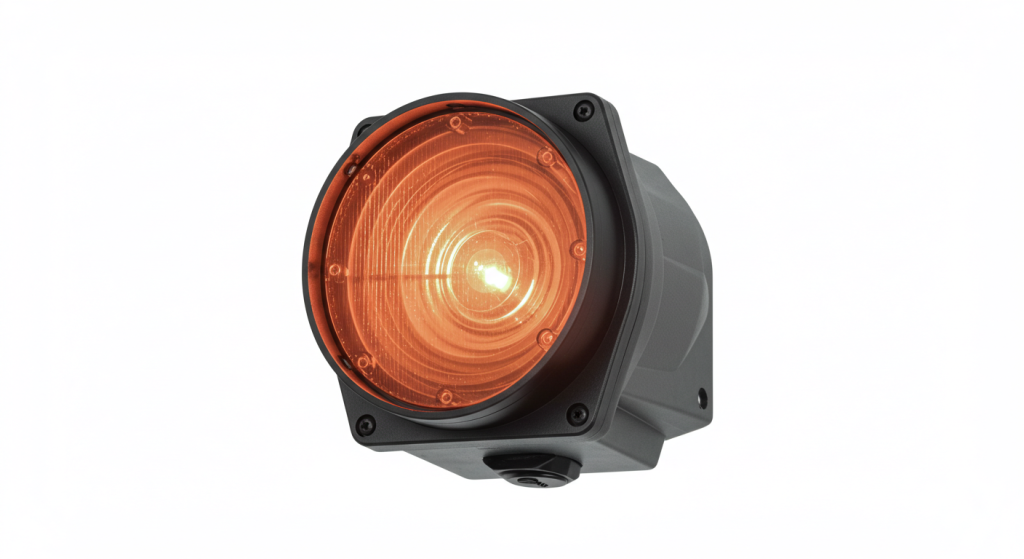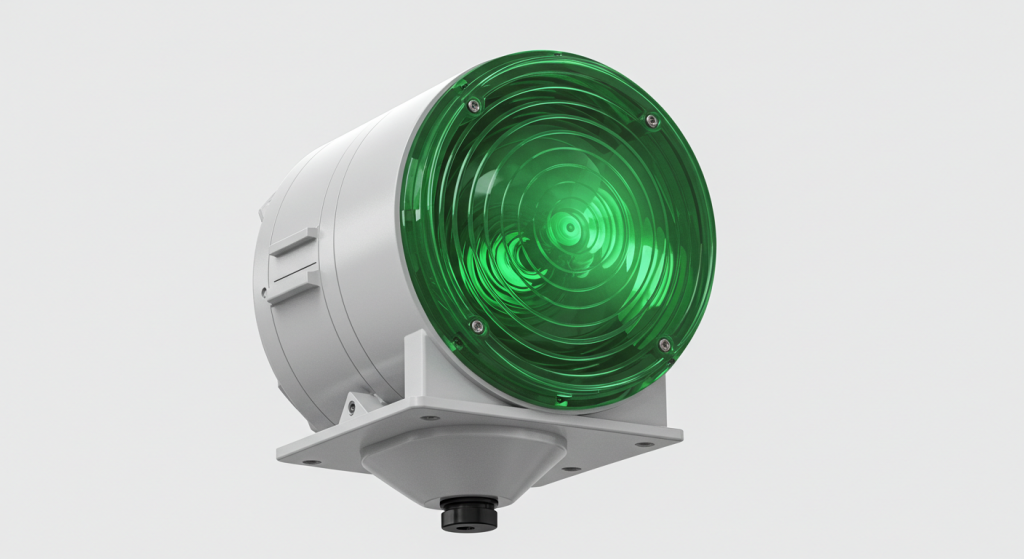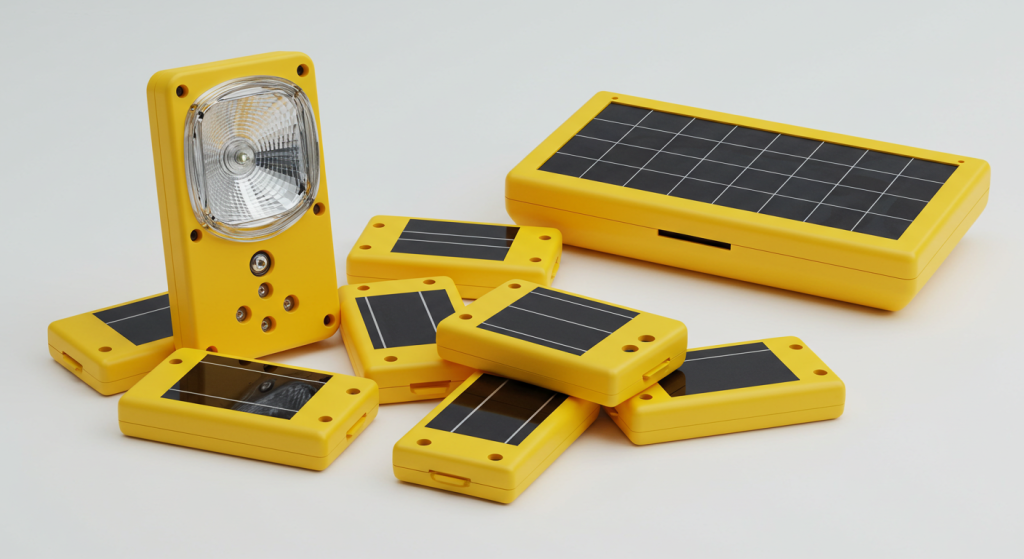At the top of high-rise buildings in bustling cities or emergency rescue bases in remote areas, the helicopter landing pad is like a relay station on an aerial bridge, and the apron lights are the key guidance to ensure smooth day and night travel of this relay station. They are not just ordinary lighting fixtures, but also aviation support facilities that integrate high technology, safety standards, and exquisite design, silently emitting light and heat behind every helicopter takeoff and landing.

Types and functions of apron lights
Boundary lights: evenly distributed along the edge of the apron, outlining the outline of the apron. Usually an embedded light fixture that emits blue light, this high brightness and strong penetrating blue light allows pilots to clearly identify the boundary range of the apron from the air at night or in low visibility conditions, ensuring accurate tire contact during landing and avoiding danger caused by rushing out of the apron, just like setting a safe “runway outline” for helicopters.
Mid line light: Installed on the center line of the apron, it is usually a white strong light fixture. When a helicopter performs landing tasks at night or under complex weather conditions, the center line light acts as a bright guiding strip, guiding the pilot to land in the correct direction and maintain a stable trajectory, helping the pilot calibrate the aircraft’s attitude and ensure that the helicopter lands accurately at the predetermined position, similar to the center line light on the runway.
Floodlight
The large-scale lighting on the apron cannot do without floodlights, which are often installed on poles or high buildings around the apron. These high-power lighting fixtures project uniform and soft light into the apron area, eliminating shadows and making the entire apron as bright as daylight. Whether it is ground crew performing maintenance, refueling and other operations on helicopters, or passengers boarding and disembarking, sufficient floodlighting can ensure precise and safe operations, avoiding accidents such as collisions and wrong operations caused by dim lighting.

Obstacle warning lights
If there are tall buildings, chimneys, iron towers and other obstacles near the apron, there must be obstacle warning lights at their top. These flashing red lights turn off at a specific frequency, following the standard pattern specified by the International Civil Aviation Organization, such as flashing 20-60 times per minute, which can attract the attention of pilots from a distance, warn potential dangers on the flight path in advance, ensure a safe distance between the helicopter and obstacles during takeoff and landing, and provide a “protective umbrella” for low altitude flying helicopters.
Technical characteristics of apron lights
High brightness and low energy consumption
Modern apron lights often use LED technology, which has unparalleled advantages compared to traditional halogen lamps and xenon lamps. On the one hand, it can output extremely high brightness, meeting the strict visual distance requirements of aviation lighting. Even from several kilometers away, pilots can capture light signals at a glance; On the other hand, LED lights have extremely low energy consumption, greatly reducing the operating costs of the apron. At the same time, their long service life reduces the maintenance workload caused by frequent replacement of lighting fixtures, truly achieving a perfect combination of high efficiency, energy saving, and long-term stability.
Anti glare design
To prevent direct exposure of strong light to the pilot’s eyes, which may cause visual interference or even temporary blindness, apron lights are ingeniously designed in terms of optics. Through the use of special lampshade shapes, internal reflector angle adjustments, and optical filters, the light is precisely controlled within the desired illumination range, ensuring sufficient illumination of the apron and eliminating glare. This allows pilots to maintain clear and comfortable visibility during aerial observation or landing, and focus on flight operations.
Adaptability to harsh environments
The apron lights need to face extreme natural conditions such as wind, rain, sand, high temperature, and low temperature. Therefore, they have excellent protective performance, and the shell is usually made of high-strength, corrosion-resistant aluminum alloy or engineering plastic material, reaching the IP (Ingress Protection) protection level standard, such as IP67 or even higher, which means that the lamp can be completely dust-proof and can still work normally after soaking in water at a depth of 1 meter for half an hour. The internal electronic components have undergone special moisture-proof, mildew proof, and earthquake resistant treatments to ensure stable and reliable operation in complex and harsh environments. Whether it is the ice and snow of the Arctic or the hot sand and dust of the desert, they can continue to emit light.
Design and installation points of apron lights
Layout planning
The layout of apron lights strictly follows the specifications established by the International Civil Aviation Organization (ICAO) and aviation management departments of various countries. The spacing, height, and angle of different types of lighting fixtures have precise requirements. For example, the spacing between boundary lights generally does not exceed 3 meters to ensure continuous and clear boundary indication; The spacing between the center line lights should be reasonably set according to the size of the apron to ensure the continuity of landing guidance. Designers need to comprehensively consider factors such as the size, shape, surrounding terrain, and expected helicopter model of the apron, and use professional aviation lighting design software to simulate and optimize, outlining the most scientific and reasonable lighting layout blueprint.

Installation height and angle
Boundary lights are usually embedded in the apron ground, flush with the apron surface, which not only avoids affecting helicopter taxiing, but also effectively emits light; The height of the center line light should be moderate, protruding from the ground for easy recognition, and not too high to cause light and shadow obstruction. The installation angle of floodlights has been finely calculated, and through multi angle combination illumination, the apron is illuminated without blind spots, avoiding light overlap or creating dark areas. During the installation process, high-precision measuring instruments are used to ensure that the position and angle deviation of each lamp is controlled within a very small range. Any slight error may affect the pilot’s interpretation of the light signal and endanger flight safety.
Application of apron lights in different scenarios
Urban high-rise apron
The apron at the top of the skyscraper has a complex surrounding environment and severe light pollution. The apron lights need to be accurately arranged within a limited space, balancing the neon light and shadow of the city while meeting the frequent takeoff and landing needs of business helicopters. The lighting fixtures here mostly adopt intelligent dimming systems, which automatically adjust the lighting intensity according to the ambient light brightness, ensuring takeoff and landing safety while avoiding strong light disturbance to residents, achieving harmonious coexistence between aviation functions and urban life, and providing convenient access for high-end business travel and emergency medical rescue.
Offshore oil platform apron
The oil platform apron located on the turbulent sea is facing challenges such as high humidity, strong salt spray corrosion, and frequent sea breeze impacts. The apron lights not only need to have strong protective performance, but also need to optimize the installation structure based on the platform shaking characteristics to ensure the stability of the lighting fixtures. The color and flashing pattern of its lights have been specially designed for pilots to quickly identify in the vast ocean background, providing an aerial lifeline for maritime material transportation, personnel rotation, and emergency rescue, and helping the steady progress of marine energy development.
Hospital emergency apron
As a vital air route to save lives, the reliability of hospital apron lights is crucial. There is an emergency backup power system equipped here. Once the mains power is interrupted, the backup power will start instantly to ensure that the lights do not go out, illuminating the landing path for helicopters carrying seriously injured patients. The lighting layout is simple and clear, guiding quickly and accurately, racing against time to shorten rescue time, allowing the helicopter to send hope for the next life, and opening a green channel for life rescue.
Maintenance and Future Development Trends of Apron Lights
Key points of daily maintenance
Regular inspections are the guarantee for the normal operation of apron lights. Professional personnel need to check the appearance of the lights for any signs of damage or corrosion, clean the dust and stains on the lampshade surface, and ensure that the light is transparent. At the same time, tighten the electrical connection parts, test the insulation performance of the circuit, verify whether the control system functions properly, including dimming, switching, synchronous flashing, and other operations. Replace aging or damaged lamps and components in a timely manner, record the maintenance situation in detail, and provide data support for subsequent management.
Future prospects
With the development of aviation technology and the promotion of smart city construction, apron lights will also undergo innovation. On the one hand, intelligent interconnection technology will be deeply implanted to achieve remote monitoring, automatic fault diagnosis and early warning. Through the Internet of Things platform, real-time interaction with airport towers and operation and maintenance centers will be achieved to improve operation and maintenance efficiency; On the other hand, the lighting will be more energy-efficient and environmentally friendly, with precise and controllable light colors, and may even integrate auxiliary functions such as meteorological monitoring and communication relay, expanding the diverse roles of apron lights in the low altitude flight ecosystem, continuously safeguarding helicopter flight safety, and illuminating every segment of future low air traffic.
Helicopter apron lights, as an indispensable part of the aviation industry, silently guard behind every helicopter takeoff and landing with their precise lighting, advanced technology, and exquisite design. From bustling cities to remote border areas, from land to sea, they illuminate the path of the sky, carrying many missions such as efficient travel, emergency rescue, and resource development, constantly moving towards a smarter, safer, and more environmentally friendly future, and continue to write a brilliant chapter in low altitude security.